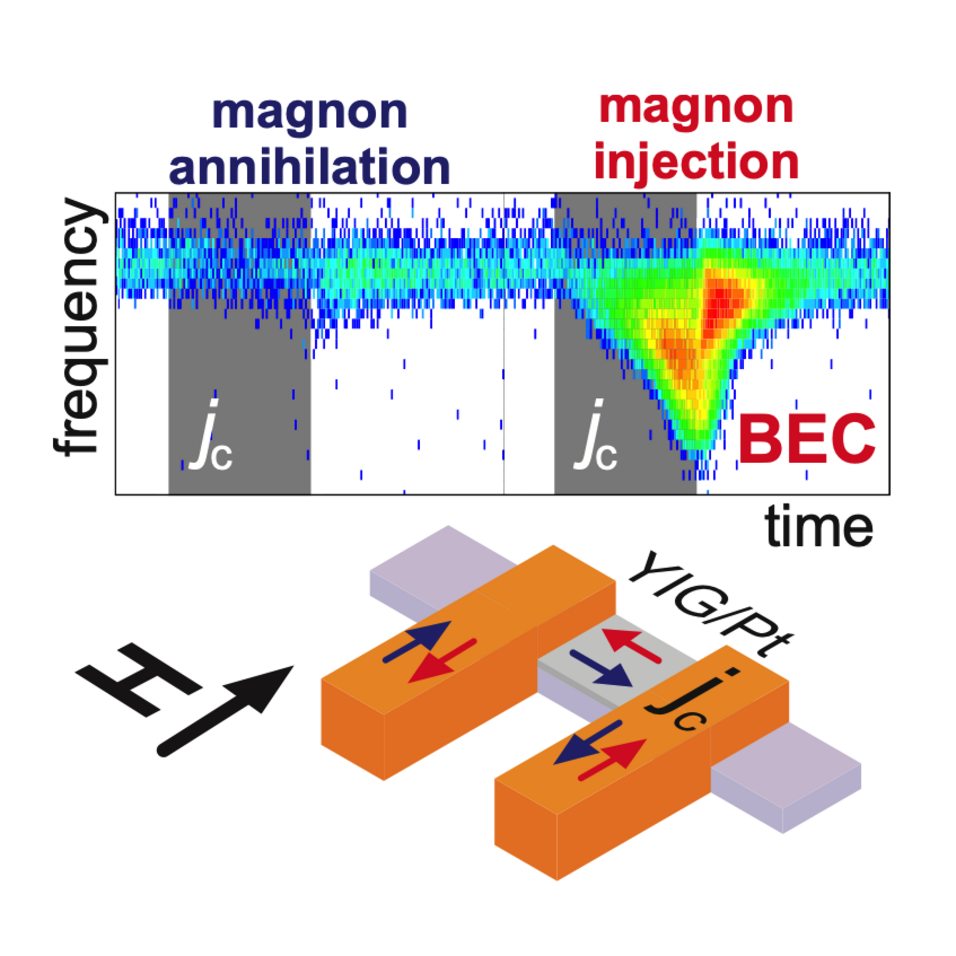The team of physicists from the Technische Universität Kaiserslautern (TUK) and the University of Vienna were able to create the Bose-Einstein condensate (BEC) using a rapid temperature shift: quasi-particles were slowly heated up and then swiftly cooled down to room temperature. The demonstration of the method used magnons, which are quasi-particles representing the quanta of magnetic excitations of a solid body.
"Spintronics is one of the largest and the most successful fields in solid-state physics," said Professor Andrii Chumak from the University of Vienna. "Our next task was to check if we can use spintronics phenomena to control this fascinating state of matter. Fortunately, our structures were already miniaturised to 100 nm scale, and the door was open. We combined our expertise and know-how in nanomagnetism and spintronics with the expertise of Prof. Burkard Hillebrands, one of the leading experts in magnon BEC."
The existence of Bose-Einstein condensates was proposed by Albert Einstein and Satyendra Nath Bose. They are a perplexing type of matter: they consist of particles that spontaneously and in unison act the same way on the quantum level, effectively becoming one entity. Formerly they were used to describe ideal gas particles, however now they have been established with atoms and quasi particles such as magnons, bosons and phonons.
Michael Schneider, the PhD researcher at the TUK who executed the experiment, pointed out to the difficulty of creating BECs due to the fact that they have to happen spontaneously. He explained that when setting up the right conditions to generate these condensates, one has to avoid introducing order or coherence: the particles have to arrive to it by themselves. The method he and his team discovered to create BEC was easier than others reported before: they only had to cool down the nano-structure quickly enough.
Continuing this research, the same team has found a way to control the formation of a magnon BEC using the spin-orbit torque. Electrons, in addition to their charge, also have a fundamental property named spin. This is somehow similar to the rotating of the Earth around itself, which creates the field we can detect with a compass. At the same time, electrons rotate around atomic cores exactly as the Earth rotates around the Sun. In materials such as platinum, the electron's orbital motion is strongly coupled to the electron spin via the spin-orbit interaction. As a result, sending the usual electric current through platinum film accumulates electrons with spin-up at the one side of the film and with spin-down at the opposite side. This spin accumulation, consequently, acts as a source of magnons in addition to the magnons redistributed by the rapid cooling mechanism. The critical experimental finding is that the SOT-driven change in the magnon population during the pulse action modifies the threshold of the BEC formation process developing after the pulse is turned off. The found threshold voltage shift was of around 8% only, which keeps it close to the threshold in which SOT allows to switch the formation of BEC on or off completely. The nature of the BEC of magnons is still under intensive investigation, and there are still many open questions. The possibility to control it by new means will help to answer some of them.
- Publication in Physical Review Letters:
Control of the Bose-Einstein Condensation of Magnons by the Spin Hall Effect
Michael Schneider, David Breitbach, Rostyslav O. Serha, Qi Wang, Alexander A. Serga, Andrei N. Slavin, Vasyl S. Tiberkevich, Björn Heinz, Bert Lägel, Thomas Brächer, Carsten Dubs, Sebastian Knauer, Oleksandr V. Dobrovolskiy, Philipp Pirro, Burkard Hillebrands, and Andrii V. Chumak
Phys. Rev. Lett. 127, 237203
Funding information:
The research was performed in the frames of ERC Starting Grant MagnonCircuits (A. Chumak), ERC Advanced Grant Super-Magnonics (B. Hillebrands) and Collaborative Research Center SFB 173 Spin+X.

